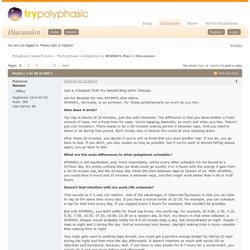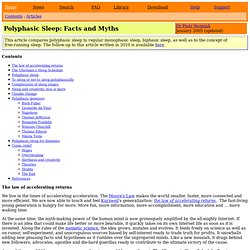

SPAMAYL Plan + Discussion (Page 1) - Adaptation - Polyphasic Sleep Forums - TryPolyphasic. Just a crosspost from my newest blog entry.

Discuss. Let me develop my new SPAMAYL plan below. SPAMAYL, obviously, is an acronym, for ‘Sleep polyphasically as much as you like’. How does it work? You nap in blocks of 20 minutes, just like with Uberman. After those 20 minutes, you decide if you’re still so tired that you need another nap. What are the main differences to other polyphasic schedule s? SPAMAYL is not equidistant, and, more importantly, unlike every other schedule it’s not bound to a 24-hour day. Doesn’t that interfere with my work/life schedule?
That sounds as if it was not realistic. But with SPAMAYL, you don’t settle for fixed nap times. Your body gets used to pushing naps around, you could get a positive energy budget by taking 10 naps during the night and then none the day afterwards. What about the adaption? Any disadvantages? Polyphasic Sleep: Facts and Myths. Contents The law of accelerating returns We live in the times of accelerating acceleration.

The Moore's Law makes the world smaller, faster, more connected and more efficient. We are now able to touch and feel Kurzweil's generalization: the law of accelerating returns . The fast-living young generation is hungry for more. At the same time, the myth-making power of the human mind is now grotesquely amplified by the all-mighty Internet. Around the year 2000, a new meme cropped up in several blogs on the net: The Uberman's Sleep Schedule.
The Uberman's Sleep Schedule The idea behind the Uberman's Sleep Schedule is to gain waking hours by sleeping the total of just 3 hours in 6 portions distributed equally throughout the day. Polyphasic Sleep – One Year Later. It’s been nearly a year since I terminated my polyphasic sleep experiment.

If you didn’t follow that experiment, for 5-1/2 months (Oct 2005 – Apr 2006) I followed a pattern of sleeping about 20 minutes once every four hours around the clock – 6 naps every 24 hours, about 2 hours of sleep per day. I blogged about it as I went along, and you can find the links to all those log entries by following the link above. Adapting to polyphasic sleep took many days, and I felt like a zombie the first week. At one point I just sat on the couch staring at a wall for 90 minutes, unable to form any thoughts.
But eventually I was able to adapt, and it was one of the most unusual experiences of my life. I was lucky to have a lifestyle that gave me every possible advantage in conducting this experiment, including working from home, a flexible schedule, and a supportive family. Cue eerie sci-fi music… Polyphasic napping The interesting thing is that I still have this ability today. Mental clarity. Everyman Sleep Schedule. Most recent update, 2010: Everyman, along with other types of polyphasic sleep, has accumulated quite a body of information since this article was written.

I myself have been on the Everyman 3 schedule for over four years now. Updated details, instructions, and even a book discussing polyphasic sleep adaptation can all be found at Everyman is another type of polyphasic sleep schedule that grew out of the experiments I first wrote about in 2000 under Uberman's Sleep Schedule. As of this writing -- January 2007 -- I have been living on the Everyman Sleep Schedule for approximately six months. How the Everyman Schedule was born The "Uberman" schedule, which was the first polyphasic schedule I experimented with, is very cool, but also really hard to adjust to. Then someone--I don't remember who was first--suggested that maybe another type of schedule would work.
The "Core Nap" Please note that not every combination of naps and core-nap seems viable. Sommeil polyphasique. Un article de Wikipédia, l'encyclopédie libre.

Le sommeil polyphasique est un mode de repos dans lequel le temps de sommeil d'une journée de 24 heures est réparti en plusieurs périodes au lieu d'être regroupé en une "nuit" (sommeil monophasique). C'est le mode habituel de sommeil chez de nombreuses espèces animales et il semble avoir été courant dans l'espèce humaine, au moins sous la forme biphasique (deux périodes), avant l'ère industrielle et la généralisation de l'éclairage continu[1]. Le sommeil polyphasique n'est pas rare chez les personnes âgées[2]. Il est présent dans certaines pathologies comme les démences. Des modalités de sommeil polyphasique ont été élaborées pour les personnes dont les activités exigent des périodes de vigilance rapprochées (militaires, navigateurs solitaires etc.)[3]. Certains proposent qu'une réorganisation des rythmes de sommeil sur le mode polyphasique permettrait d'en réduire la durée totale, jusqu'à pouvoir se contenter de 2 à 5 heures par jour.